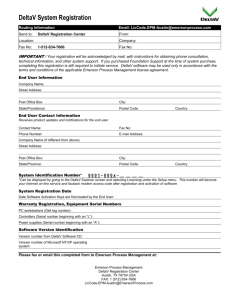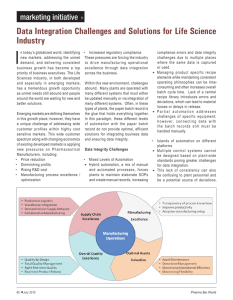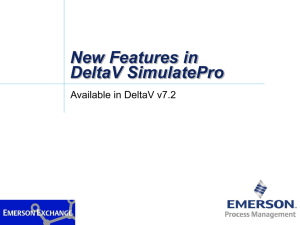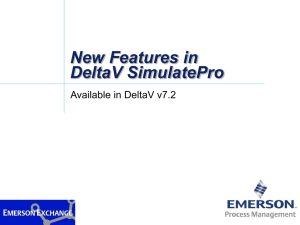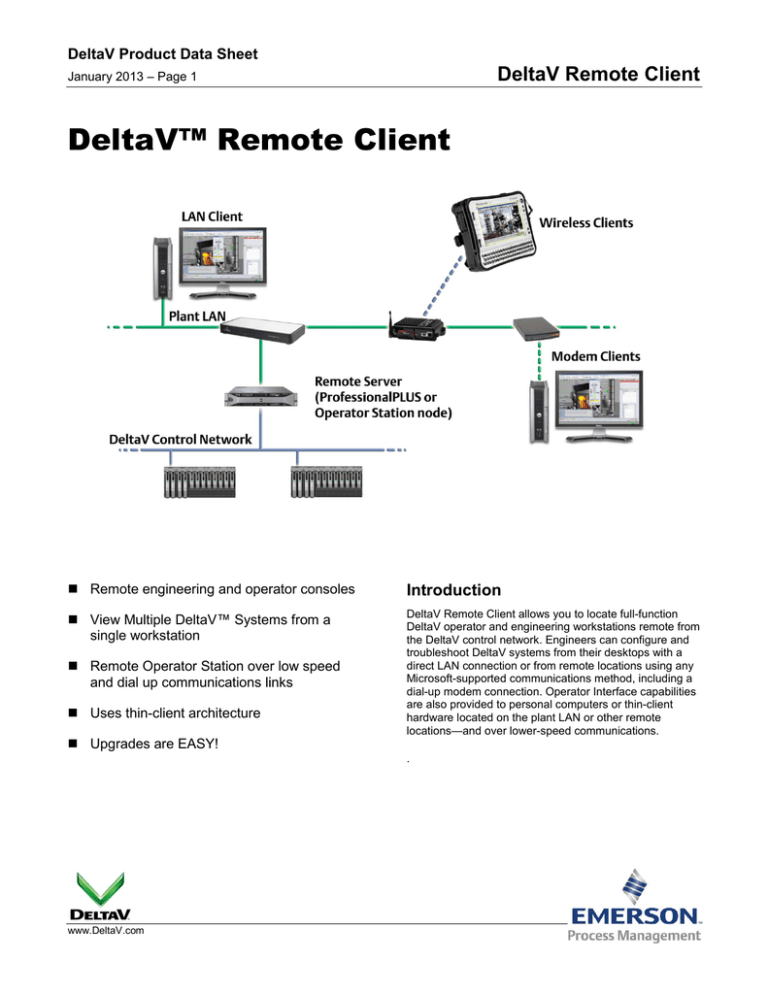
DeltaV Product Data Sheet
DeltaV Remote Client
January 2013 – Page 1
DeltaV™ Remote Client
Remote engineering and operator consoles
Introduction
View Multiple DeltaV™ Systems from a
single workstation
DeltaV Remote Client allows you to locate full-function
DeltaV operator and engineering workstations remote from
the DeltaV control network. Engineers can configure and
troubleshoot DeltaV systems from their desktops with a
direct LAN connection or from remote locations using any
Microsoft-supported communications method, including a
dial-up modem connection. Operator Interface capabilities
are also provided to personal computers or thin-client
hardware located on the plant LAN or other remote
locations—and over lower-speed communications.
Remote Operator Station over low speed
and dial up communications links
Uses thin-client architecture
Upgrades are EASY!
.
www.DeltaV.com
DeltaV Product Data Sheet
January 2013 – Page 2
Benefits
Remote engineering and operator consoles.
Operate, configure, and diagnose your process from
locations outside your DeltaV control network while still
using your DeltaV and Windows security. Now it’s possible
to manage and monitor your process from remote
locations using virtually any type of communications. From
a single Remote Client you can easily open multiple
windows to simultaneously view different DeltaV systems
– even systems at different revision levels (7.2 or later).
View Multiple DeltaV Systems from a single
workstation. You can easily switch the connection
between different DeltaV systems. You can connect using
any existing computer shared with other functions. Your
engineers and operators can be wherever they need to be
and still manage the process. You can configure, operate,
and troubleshoot the system from a computer located
anyplace in the world. Just make a connection to the
Remote Client server and you can access all the functions
that are normally available to you. Maintain your
configuration, run diagnostics, build displays, and help
operators troubleshoot the process without going to the
control room or traveling to the site.
Remote Operator Station over low-speed and
dial-up communications links. DeltaV Remote Client
provides the flexibility to operate or configure your plant
from your internal plant LAN or from hundreds of
kilometers away using standard communications
hardware, including satellite, microwave, VPN’s or dial-up
modems.
Uses thin-client architecture. DeltaV Remote Client
uses the latest Microsoft Terminal Server technology to
provide the client connection to the server. DeltaV
software does not need to be installed on the remote
client. The Remote Client software is less than 500KB in
size and will run on any workstation with a Microsoft
Windows 32-bit operating system. The client does not
require high power or sophisticated workstation hardware
to function.
Upgrades are EASY! Since the same client can
connect to different DeltaV versions, the client software
does not need to be upgraded when you migrate to a new
DeltaV version.
Product Description
DeltaV Remote Client is a thin-client application that
connects through a DeltaV ProfessionalPLUS or Operator
Station node. DeltaV Remote Client provides full remote
capability to all DeltaV applications configured for remote
access. These remote workstations are physically
connected to the ProfessionalPLUS Station or Operator
Station through a dedicated network card on these
servers.
DeltaV Remote Client
A Remote Client may be utilized for Operator, Engineering
or Maintenance needs. Each remote session functions as
an individual station with the same capabilities as a
connected workstation. On direct high-speed LAN
connections, users may not even realize they are working
at remote terminals.
The DeltaV Remote Client uses the standard Microsoft
security and standard DeltaV security to prevent
unauthorized use of the DeltaV applications. Persons on
the network who do not have authorization are denied
access to the server, while authorized DeltaV users are
allowed access according to their normal DeltaV security
privileges.
In addition, each session can be reserved for a specific
group of users or group of client nodes both to help
prevent unauthorized access and to ensure that sessions
are kept available for critical users.
A Remote Client can connect to multiple servers on
different DeltaV systems. This will allow multiple
engineering windows to be open on the same monitor at
the same time. The user can also transfer configuration
files, displays, and other information among the different
DeltaV systems using the client PC.
If the client workstation is equipped with multiple monitors,
the different Remote Client session windows can be
positioned across these monitors. Remote windows can
also be used on a dual monitor window size.
Operator Capabilities
Each Remote Client operator session is totally
independent and can have its own set of assigned areas.
Alarms are reported only to the session(s) to which those
areas are assigned – just like a standard operator station.
Alarms can follow the operator from one terminal to
another by logging into the same session on each remote
client terminal. DeltaV users have all of the same control
capabilities as they would on any other DeltaV station.
Operational capabilities are designed to follow the user.
Users can navigate through displays, select items, make
control actions, view trends, view events, view historical
data from any historian, and perform all of their tasks. No
special setup or conversion is required. All of the display
navigation, toolbar buttons, alarm banners, and data work
exactly the same as on a standard Operator Station.
Audible alarm is supported on any remote client that has a
sound card. Alarms are sent from the server for local
alarming. From the client, the user can silence the horn,
acknowledge alarms, and participate in global horn
acknowledgment groups.
DeltaV Product Data Sheet
January 2013 – Page 3
The Remote Desktop software can be installed on a
DeltaV operator workstation that will allow the operator or
engineer to access other DeltaV systems from an operator
workstation. Operators in a central control room can use
the remote client to monitor and control other DeltaV
systems during off-shifts when other control rooms might
be unmanned or as an “extra pair of hands” during plant
startup or shutdown. The engineer can access other
DeltaV systems for engineering tasks that allows
engineering to be done from a single centralized location.
Engineering Capabilities
The client can perform any engineering and configuration
function. From the Remote Client, you can set up your
system using the DeltaV Explorer, configure and
troubleshoot controller modules using Control Studio and
Control Studio Online, and build operator displays and
trend charts for use on other workstations.
The DeltaV Remote Client provides access to real-time
data for engineering applications such as Control Studio
Online and operating data for display development. Any or
all of the Remote Client sessions can be licensed as
Professional Stations. The Remote Client server will
support up to fifteen concurrent engineering users with up
to sixty total database connections to the
ProfessionalPLUS (see information below for more
information on remote engineering sessions).
Maintenance Capabilities
The remote sessions can also be licensed as a DeltaV
Maintenance Station to allow your maintenance shop to
use the Remote Client to monitor device alerts and DeltaV
system health from any PC. Since the client can make
connections to multiple systems at the same time one
computer can serve as the Maintenance Station for
several DeltaV systems.
Architecture
DeltaV Remote Client is implemented via a client
computer and a server computer. The server computer is
a DeltaV node with DeltaV software installed. This node
can be either the ProfessionalPLUS Station or an
Operator Station node that is specifically dedicated to
serving DeltaV information to remote clients. An
Application Station cannot be used as a Remote Client
Server.
The client computer can be any 32-bit Windows-based
computer or thin-client hardware capable of running the
Microsoft Remote Desktop Connection software. DeltaV
software is not installed on this computer, so a DeltaVcompatible workstation is not required for the client
application.
DeltaV Remote Client
System Setup
A Remote Client session can be connected to any Remote
Client server on the DeltaV system. Remote Clients are
connected using standard Ethernet communications and
do not use the redundant DeltaV Control Network for
communications. As with any outside connection to the
DeltaV system, we suggest that a router be installed
between the DeltaV system and the plant LAN to prevent
unnecessary plant LAN traffic from getting to the server.
In the event of a client failure, simply use another
workstation to log into the DeltaV system. In the event of
a server failure, you can log into any other Remote Client
server configured on the DeltaV system.
A Remote Client server allows users to host a
recommended maximum of fifteen (15) concurrent
operator and engineering sessions from a single Operator
Station node server and a recommended maximum of
seven (7) concurrent sessions on a ProfessionalPLUS
node server. These sessions can be a combination of
engineering and operator sessions. If normal use will
require multiple engineering sessions or more than 4
operator sessions in constant use, we strongly
recommend a dedicated server for engineering sessions
and operator sessions rather than share the same server.
A single Remote Client server can host a recommended
maximum of eight (8) concurrent remote operator sessions
running –sessions with DeltaV Operate running. All of the
concurrent sessions can be open at the same time as long
as the total of all datalinks on all open displays does not
exceed 7200 links. Full operator, display development
and “view only” sessions all count against the active link
limit.
The terminal server architecture used to support the
remote client sessions is designed to be disconnected
from the server when not in use. It is recommended that
DeltaV Remote Client sessions not be used as full time
(7/24/365) operator workstations.
When the Operator Station is used as the Remote Client
Server, its sole purpose is to host remote sessions. It
cannot be used as an Operator Station or a Professional
Station; only the connected remote sessions can be
Operator and Professional Stations.
The ProfessionalPLUS Station is used as the Remote
Client server primarily to support systems that require
limited remote access for troubleshooting and less than
full-time operator tasks. The ProfessionalPLUS station
may be used for all of its typical functions. However, when
the ProfessionalPLUS station is also used for local
engineering, it can impact the response time to the
Remote Client sessions and reduce performance. If
higher performance engineering and operator access is
desired on the Remote Clients, a dedicated Operator
Station node should be used as the Remote Client Server.
DeltaV Product Data Sheet
January 2013 – Page 4
Data Accessibility
The DeltaV Remote Client server can be set up with a
local DeltaV Continuous Historian and Event Chronicle.
The server can collect up to 250 parameters in a local
DeltaV Continuous Historian. The server can collect
alarms and events for all of the areas assigned to the
Alarms and Events subsystem on the server. This data
can be seen by any of the Remote Client sessions with the
Process History View application. The Process History
View application on a Remote Client can also be sued to
view the alarms and events from an Event Chronicle on
any other DeltaV workstation.
The DeltaV Remote Client server supports a single copy
of the settings for the Batch Operator Interface. All
sessions using the Batch Operator Interface from one
server will use the same set of filters, column widths,
colors and other user-configurable settings in the
application. Changes made to the settings will be reflected
in all sessions and not limited to the specific session
making the changes. This includes the setting of which
Batch Executive the BOI is connecting to. This also
applies to the Campaign Manager Operator Interface. All
sessions from the same server will use the same settings.
DeltaV Remote Client
Remote Engineering sessions are included in the
maximum of 60 database connections to the
ProfessionalPLUS. This means that once the 60 database
connections are consumed at the ProfessionalPLUS, no
further engineering applications can be started from any
workstation – remote or local.
Remote graphic editing sessions allow a maximum of one
copy of the DeltaV Operate configure mode open on each
server. This means that only one remote session can be
editing graphics at any one time for each server. If you
require multiple, concurrent display configuration sessions,
multiple Remote Client servers will have to be used.
Additionally, Display Audit Trail does not support remote
display configuration.
The Remote Client subsystem is available in the DeltaV
Explorer under the ProfessionalPLUS and Operator
Station nodes. Configuration is easy, requiring only the
assignment of plant areas to define the span of control. If
you need to ensure that specific workstations or users will
always be able to log onto a remote session, you can
reserve lists of users or remote nodes.
Remote Session Options
Each Remote Client session can support a different set of
functionality. Remote Client sessions are sized and setup
exactly as you would configure a local workstation.
For example, to configure a remote operator session,
choose an appropriate Operator Station license, full span
for alarming in that session. To configure a remote
engineering session, choose an appropriate Professional
Station license, full span for alarming in that session. If no
alarming is required, only the zero span Operator or
Professional Station license is necessary.
A DeltaV Remote Client session can be used on a DeltaV
Operator Station that will allow the plant operator or
engineer to use the DeltaV Remote Client to access and
control other DeltaV systems from the operator
workstation.
A remote, view-only workstation can be created by
choosing an Operator Station and setting up the DeltaV
security for each user of the view-only workstation so that
users do not have authority to make operating or
engineering changes.
Sessions can be reserved for use by specific users and
nodes to ensure availability for critical uses.
DeltaV Product Data Sheet
DeltaV Remote Client
January 2013 – Page 5
Operator Station node
configured as a Remote
Client Server
Remote Client Subsystem
DeltaV Remote
Client Sessions
+
DeltaV Explorer showing setup for Remote Clients
Performance and Integrity
There are many factors that will influence the performance
of the Remote Client including communications method
and speed, type of computer used for the Remote Client
Server, type of computer used on the Remote Client
Sessions, number and type of sessions connected to the
Remote Client Server.
Communications and speed.
Performance of the Remote Client is highly dependent on
the speed of communications, type of communications
link, and network traffic.
For local, high speed LAN communications; the
performance of all functions is comparable to a directly
connected DeltaV workstation. For WAN and all other nonLAN communications (microwave, modem, etc), the
performance can vary from 2 to 10 times slower than a
LAN connection. For example, operations that take 2
seconds at LAN speeds can take 10-12 seconds at
modem speeds. Therefore, if you plan to use a low
communication speed Remote Client session for an
Operator Interface; it is critical that you specifically design
displays for use at this low speed. The use of bitmaps and
large amounts of datalinks will seriously impact the
performance of the client. We do not recommend applying
the Remote Client at speeds lower than 28.8 kbps.
DeltaV Product Data Sheet
DeltaV Remote Client
January 2013 – Page 6
Communications and integrity
Communications integrity can be impacted by high
network traffic and poor communication connections. In
wireless communications, atmospheric conditions can
impact speed of response and loss of communications. A
dedicated control LAN without a connection to the plant
LAN provides a high level of integrity. An open plant LAN
with general business network traffic, satellite, modem,
microwave, wireless or other non-LAN connections all
provide a medium level of integrity. Dial-up modems
provide a low to medium integrity level.
Computer Hardware
Both the Remote Client Server computer and the Remote
Client Session computer have an impact on the
performance. For the Remote Client server, the model and
configuration of the hardware will impact the performance.
For example, a dual processor with 2 GB of memory will
provide better performance than a small single processor,
especially in a multi-user situation. Remote Client Session
hardware can also make a difference in performance.
When the remote client is used for operator interface
applications, the CPU speed plus the memory and type of
video card can make a 1 to 2 second difference in the
display call up times between older slower PCs and the
new, faster PCs with improved bus and video capabilities.
Response times for engineering activities are not impacted
by differences in the Remote Client Session hardware.
Additionally, if other software applications are running on
the Remote Client Session computer, the performance
and software integrity may be affected.
Remote Client Sessions
The number of concurrent users on a single Remote Client
Server impacts the performance. As additional users
consume the shared resources on the server, the
performance of the clients may decrease. The activities of
the Remote Client sessions will also impact the
performance. Operators will create more loads on the
Remote Client Server than engineering clients. Operators
working in plant upset conditions, responding to alarms,
and paging between displays will create higher loading
than operators at more normal times.
As with any multi-user client/server solution, customers
need to be aware of the risks in using common hardware
to support multiple operator workstation clients. When
deploying this terminal server solution, users must
understand their specific risk of a server failure
simultaneously impacting the ability of multiple operators
to access the system or having the actions of a single user
impact the availability of the server to other users. The use
of a terminal server-based operator interface may not be
advisable in all situations, and Emerson Process
Management assumes that the customer is aware of these
risks prior to deploying this solution in their specific
situation.
Support
Full support will be provided for any DeltaV Operator
Station that is being used as a Remote Client session to
another DeltaV system. Additionally, full support will be
provided for a Remote Client computer when the computer
is dedicated to DeltaV Remote Client use, is running the
current Microsoft O/S, and is certified for that O/S. Full
support cannot be provided if the computer is running any
other software.
For any communications problems and all remote client
sessions, Emerson Process Management will provide
technical support to the best of its ability until it is
determined that the issue is caused by conditions outside
the control of Emerson Process Management or that the
issue is caused by equipment supplied by others.
Customer is responsible for resolving problems caused by
conditions outside the control of Emerson Process
Management or caused by equipment supplied by others.
System Compatibility
DeltaV version 8.4 or later is required on the Remote
Client server to use the specifications in this document.
The Remote Client Server node must be installed on a
server-class computer running the Microsoft Server
operating system.
Remote Client sessions may be run on any computer
hardware that will support the Microsoft Remote Desktop
Connection software.
Must run Microsoft Remote Desktop Connection software.
(Available as a free download from Microsoft). The
software can be downloaded from
http://www.microsoft.com/windowsxp/pro/downloads/rdclie
ntdl.asp. Microsoft supports the Remote Desktop
Connection software on any Windows 32 bit operating
system including Windows NT.
..
DeltaV Product Data Sheet
DeltaV Remote Client
January 2013 – Page 7
Ordering Information
Description
Model Number
ProfessionalPLUS Station Software Suite
VE2101Sxxxx
Base Station Software Suite
VE2106
Event Journal
VE2143
Operator Station Software Suite, Full Span of Control**
VE2104
Operator Station Software Suite, Zero Span of Control**
VE21040000
Professional Station Software Suite, Full Span of Control**
VE2102
Professional Station Software Suite, Zero Span of Control**
VE2102S0000
Maintenance Station Software Suite*
VE2105
*Assignable to the remote client sessions.
** Assignable to the remote client sessions. Span of Control is defined by how many DSTs can be assigned to the Alarms and
Events of a workstation (e.g., Full Span of Control = 30,000 DSTs.
Related Products
Base Station. Centralized DeltaV applications,
where the combination of applications included are
user selected on a DeltaV workstation.
Maintenance Station Software Suite.
Centralized system and device maintenance,
including device calibration, device and hardware
alerts and diagnostics on a DeltaV workstation.
Operator Station Software Suite. Centralized
operations and diagnostics on a DeltaV workstation.
Professional Station Software Suite.
Centralized operations, engineering, and diagnostics
on a DeltaV workstation.
ProfessionalPLUS Station Software Suite.
Centralized operations, engineering, configuration
database, and diagnostics on a DeltaV workstation
DeltaV Remote Access Service. Enables
remote configuration, operation, and diagnostics from
DeltaV workstations.
Not Supported Products
DeltaV Operate for PROVOX. Replace PROVOX
consoles for a single integrated operator interface for
both PROVOX and DeltaV systems.
DeltaV Operate for RS3. Replace RS3 consoles
for a single integrated operator interface for both RS3
and DeltaV systems.
Related Hardware Products
DeltaV Workstation Hardware Select from a
variety of PC and server hardware, tested and
preloaded with DeltaV software.
DeltaV Product Data Sheet
DeltaV Remote Client
January 2013 – Page 8
Prerequisites
Each client session requires one or more standard
DeltaV workstation licenses, and the licenses may be
different for each defined session.
If the Remote Client Server is an Operator Station, a
Base Station license is required to allow the node to
communicate with the DeltaV Control Network. This
license is assigned to the server itself and not to the
sessions.
If the Remote Client Server is an Operator Station, an
Event Chronicle license must be assigned to the
server node to enable the event collection.
If the Remote Client Server is a ProfessionalPLUS
Station, no server license is required.
All displays must be using the DVSYS functionality on
the operator interface.
To locate a sales office near you, visit our website at:
www.EmersonProcess.com/DeltaV
Or call us at:
Asia Pacific: 65.6777.8211
Europe, Middle East: 41.41.768.6111
North America, Latin America:
+1 800.833.8314 or
+1 512.832.3774
Each Remote Client Server requires a Microsoft
Server Client Access License (CAL) for each session.
These are the basic access licenses required for any
user to connect to a server. A DeltaV server comes
with 10 CALs included in the base setup. If you will
have more than 10 remote devices connecting to a
server, you will have to supply additional CALs
Each Remote Client Session requires a Microsoft
Terminal Server Client Access License (TSCAL).
Each remote device connecting to a terminal server
requires a TSCAL (in addition to the CAL). There are
no TSCALs included in the DeltaV setup. Licenses
must be purchased for all devices that will be
connecting to the server.
Emerson Process Management is not able to provide
the CAL or TSCAL license packs. They can be
purchased from Microsoft or another third party
vendor.
For large power, water, and wastewater applications
contact Power and Water Solutions at:
www.EmersonProcess-powerwater.com
Or call us at:
Asia Pacific: 65.6777.8211
Europe, Middle East, Africa: 48.22.630.2443
North America, Latin America: +1 412.963.4000
© 2013 Emerson Process Management. All rights reserved. For Emerson Process Management trademarks and service marks, go to:
http://www.emersonprocess.com/home/news/resources/marks.pdf.
The contents of this publication are presented for informational purposes only, and while every effort has been made to ensure their accuracy, they are not to be
construed as warrantees or guarantees, express or implied, regarding the products or services described herein or their use or applicability. All sales are governed
by our terms and conditions, which are available on request. We reserve the right to modify or improve the design or specification of such products at any time
without notice.
www.DeltaV.com

